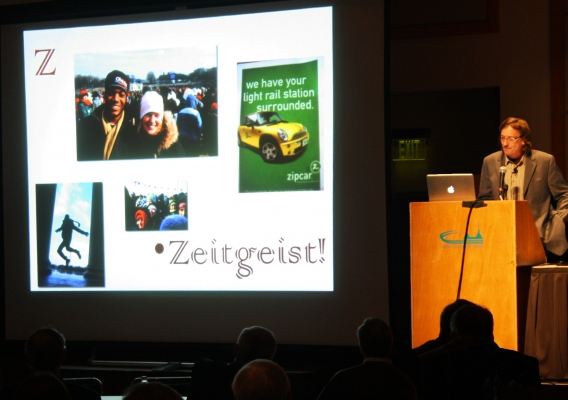Conference shows electric vehicles have turned a corner in 2011

If anyone doubted Detroit could produce a reliable electric car that can be charged at home and make several trips without recharging, the proof was parked in the Oregon Convention Center: a 1917 Detroit Electric. Production of that car, which could travel up to 80 miles on a charge, began in 1907.
The Detroit Electric and conceptual descendents, such as the sporty Tesla Roadster and Nissan Leaf, served as backdrop to E.V. Road Map 3, a forum to discuss the benefits of electric vehicles and plan for their future. Sponsored by Portland State University and Portland General Electric, the conference came at a turning point for electric vehicles, said John MacArthur, director of OTREC’s Transportation Electrification Initiative.
“Once 2011 hit, we went from the theoretical to the applied,” MacArthur said. “Automakers are rolling out the vehicles, charging stations are popping up, and now they’re starting to be seen and tested.”
Perception remains the largest barrier to wider adoption of electric vehicles, he said. “There’s still this ‘range anxiety’ out there,” that is, people worry if the car has enough juice to get to their destination and back. “But once they drive one, they realize it’s not a big deal.”
That’s because most people don’t drive nearly as far as most electric vehicles’ range of 70 miles or more. Take commutes to downtown Portland: from Southeast 82nd Avenue and back, it’s 11 miles; from Hazel Dell, Wash., and back, it’s 22 miles.
“People have no concept of how many miles they drive every day,” MacArthur said. “They know how long their trip takes, but not the number of miles.” This remains one of the biggest barriers for EV adoption and a focal point for public outreach, which the attendees discussed during afternoon breakout groups.
Speakers at the conference, including Multnomah County Commission Chair Jeff Cogen and U.S. Sen. Jeff Merkley, stressed the environmental and energy-security benefits of electric vehicles. In a video address, Merkley said that the United States sends $1 billion per day out of the country by buying foreign oil, money that could instead be poured into a domestic energy system.
In addition to lessening dependence on foreign oil, electric vehicles can run on electricity generated from cleaner sources. The absence of tailpipe emissions could have a profound effect on urban areas, MacArthur said. “The local air quality is the biggest issue,” he said. “If we don’t have benzene and other toxics in the local airshed anymore, what is the impact of that?”
The conference featured a keynote address by Chris Paine, director of the documentary “Who Killed the Electric Car” and the new film “Revenge of the Electric Car.”
Conference speakers and attendees stressed the importance of clearing up misconceptions about electric vehicles. Buying electric fleet vehicles can help raise visibility and acceptance of the technology, they said.
OTREC research has laid the groundwork for electric vehicle fleets. A paper presented at the Transportation Research Board’s annual meeting by the research team led by Professor Miguel Figliozzi in January focused on the financial side of electric fleets. If gasoline hits over $4 per gallon and EVs are highly utilized, it makes economic sense to buy electric, assuming the existing tax credit continues. . The paper grew out of an OTREC project titled “Green and Economic Fleet Replacement Modeling.”
